How do people overcome hardships?
The United States had experienced several major economic swings before the Great Depression in the 1930s. During World War I, the U.S. government had vigorously encouraged farmers to expand crop and livestock outputs to feed the army and U.S. allies in Europe. They guaranteed high prices and appealed to the farmers’ patriotism through slogans like "Food Will Win the War." Farmers borrowed to buy new machinery to replace the labor lost by sons and hired hands drafted into the military.
As Food Demand Drops, Farm Prices Collapse
In 1920, with the war over and the demand for farm goods decreasing, the U.S. government with little warning announced that it was ending price supports. The farmers, however, continued to produce at near record levels creating surplus commodities that sent prices plummeting. Until then, land prices had been rising rapidly as farmers and non-farmers saw buying farms as a good investment. With the collapse of farm prices, the land bubble burst, often dropping the market value of the land well below what the investor owed on it. The post-war depression did not start with the Stock Market Crash of 1929. For the Midwest, it started in 1921, and farmers and the small towns that depended on the land were hit hard.
In the 1920s, only slightly less than half of the U.S. population lived on farms. When farmers were not making money, they could not buy the products that factories were making. When factories couldn’t sell their products, they laid off their workers. The workers could not buy the factory output either, meaning more lay-offs, and the country fell into a downward spiral.
However, not everyone saw the pattern emerging. Many thought that because the stock market had been on a sustained upswing, it was a good place to invest money. When it became obvious that the price of stocks far outpaced their productive capacity, investors lost confidence and began selling before prices dropped further. Panic ensued, and the market dropped sharply. With factories closing and banks failing, unemployment continued to rise. Without the safety nets of today like Social Security, many families found themselves without income, losing their homes and facing poverty. The situation during the 1920s was bad; it got much worse in the 1930s.
Farm Families and the Great Depression
Farm families were often better suited to weather hard times than town residents. Farmers could grow their own food in large gardens and raise livestock to provide meat. Chickens supplied both meat and eggs, while dairy cows produced milk and cream. Many women had sewing skills and began producing much of their family’s clothing. Wherever they could, families cut down on expenses. A major problem was taxes, which had to be paid in cash. Families that could not pay taxes sometimes lost their homes and farms. The state and governments slashed costs wherever they could. Schools cut teachers’ salaries. Many people remember that while they had little money, they didn’t feel humiliated because everyone around them also was poor.
The federal government began to provide relief to offset the impact of the Depression. Iowan Henry Wallace, a corn scientist and farm journal editor, was named secretary of agriculture. He saw that low prices were brought about by surplus production. The federal government adopted a policy that would guarantee farmers a higher-than-market price for their crops and livestock if they would reduce their production. The Agricultural Adjustment Act began sending much needed checks to farmers who would sign up for the system, and the money was a great stimulant to the economy. It saved many a farm from foreclosure.
Extreme Weather and the Great Depression
The environment also seemed hostile to the farmers during the 1930s. The winters of 1934 and 1936 were especially long and cold. The summer of 1936 saw one of the worst droughts ever recorded and crops dried up in the fields. Livestock died for lack of food and water.
West of Iowa, on the Great Plains, lands that could no longer sustain the grasses that held the soil in place began to lose topsoil to the strong hot winds. So much dust was picked up that soon great dark clouds, not of rain but of soil particles, began to drift eastward. Iowa was never hit as hard by the Dust Bowl as Kansas and Oklahoma, but the clouds of dust that blocked out the sun and found their way through any cracks in the house around windows or doors left a lasting impression on those who lived through them.
Times were tough through the entire decade of the 1930s. While government programs helped, it was the start of World War II and the renewed demand for manufactured goods and farm products that lifted the United States out of the worst economic period in its history. It was, however, at a heartbreaking cost in American lives.
Supporting Questions
What factors caused the Great Depression?
- Crowd of People Outside the New York Stock Exchange Following the Stock Market Crash, 1929 (Image)
- Finance Officer W.W. Tarpley Interviews Raymond Tarver about Bank Closings, January 5, 1940 (Document)
- Interview of George Mehales about the Stock Market Crash of 1929, December 1938 (Document)
- IPTV's "The Great Depression: Stock Market Crash," 1979 (Video)
How did farmers interact with and adapt to the environmental changes of the Dust Bowl?
- Proposed Migrant Camps in California for Relocated Dust Bowl Families, 1935 (Map)
- Dust Storm in New Mexico, April 1935 (Image)
- Young Man Removing Soil that Blocks the Highways near Guymon, Oklahoma, March 1936 (Image)
- Dust Bowl Farmer in Cimarron County, Oklahoma, April 1936 (Image)
- Farmer Pumping Water to his Dry Fields in Cimarron County, Oklahoma, April 1936 (Image)
- Dust Storm in Elkhart, Kansas, May 1937 (Image)
- "FDR Hears Todd Records" Newspaper Article, between 1940 and 1941 (Document)
- Interview with Imogene Chapin from Arvin Farm Security Administration (FSA) Camp in California, August 1, 1940 (Audio)
- Interview with Flora Robertson about Dust Storms in Oklahoma, August 5, 1940 (Audio)
- Interview with Mexican Migrant Jose Flores about Farm Security Administration (FSA) Camps, 1941 (Audio)
- Ethnographer Charles Todd with Mexican Men and Boys at an FSA Camp in El Rio, California, 1941 (Image)
How did people survive the Great Depression when they do not have enough money?
- Letter from Martha Fast to First Lady Lou Henry Hoover, January 2, 1931 (Document)
- Response from First Lady Lou Henry Hoover's Secretary to Martha Fast, January 7, 1931 (Document)
- Dispossessed Arkansas Farmer in Bakersfield, California, 1935 (Image)
- Workmen at the Norris Dam in Tennessee, between 1935 and 1940 (Image)
- Squatters along the Highway near Bakersfield, California, November 1935 (Image)
- President Franklin Delano Roosevelt and First Lady Eleanor Roosevelt in Denver, Colorado, ca. 1936 (Image)
- "Migrant Mother" Florence Thompson with Her Children in Nipomo, California, February/March 1936 (Image)
- Oklahoma Farm Family on Highway between Blythe and Indio, California, August 1936 (Image)
- Rehabilitation Client Repays his Loan in Smithfield, North Carolina, October 1936 (Image)
- Automobile Camp North of Calipatria, California, March 1937 (Image)
- Swimming Pool Created by CCC (Civilian Conservation Corps) Dam in Huntingdon, Pennsylvania, July 1941 (Image)
| Great Depression and the Dust Bowl Source Set Teaching Guide |
| Printable Image and Document Guide |
Crowds Outside of the New York Stock Exchange, 1929

Description
A crowd of people standing outside of the New York Stock Exchange (NYSE) after the stock market crash of 1929. It was on "Black Tuesday," October 29, 1929, that investors traded around 16 million shares on the NYSE in a single day that resulted in billions of dollars being…
Finance Officer W.W. Tarpley Interviews Raymond Tarver about Bank Closings, January 5, 1940

Description
This is an interview by W.W. Tarpley, who was a finance officer in the U.S. Treasury, of Raymond Tarver. Tarver gives his personal account of the effects of the closing of the bank he worked in during the Great Depression.
Interview of George Mehales about the Stock Market Crash of 1929, December 1938

Description
Interview with George Mehales by R.V. Williams. Through this oral history interview, George shares stories of his life including what happened to him during the stock market crash of October 1929.
IPTV's "The Great Depression: Stock Market Crash," 1979
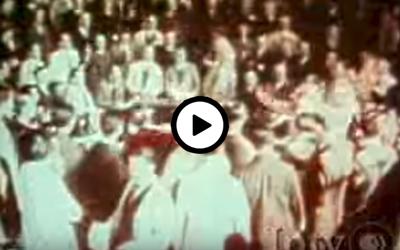
Description
All parts of the nation were faced with the worst economic depression in history in 1929. Iowans suffered along with the rest of the nation. This video from Iowa Public Television explains causes and effects of the stock market crash of 1929.
Proposed Migrant Camps in California for Relocated Dust Bowl Families, 1935
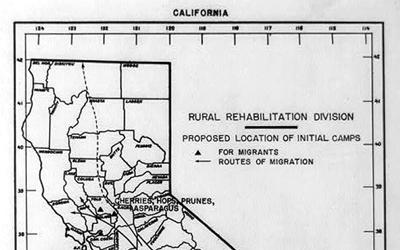
Description
During the Great Depression, a series of droughts combined with non-sustainable agricultural practices led to devastating dust storms, famine, diseases and deaths related to breathing dust. This caused the largest migration in American history.
Dust Storm in New Mexico, April 1935
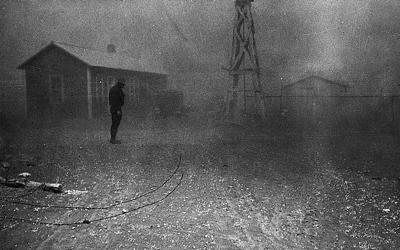
Description
Many factors led to the Dust Bowl. An increased demand for wheat during World War I, the development of new mechanized farm machinery along with falling wheat prices in the 1920s, led to millions of acres of native grassland being replaced by heavily disked fields of…
Young Man Removing Soil that Blocks the Highways near Guymon, Oklahoma, March 1936
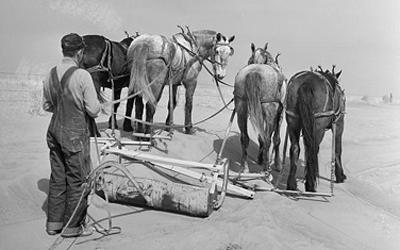
Description
This young man in overalls is removing drifts of soil from the highways near Guymon, Oklahoma. These piles of soil blocked roadways throughout the area during the Dust Bowl.
Dust Bowl Farmer in Cimarron County, Oklahoma, April 1936
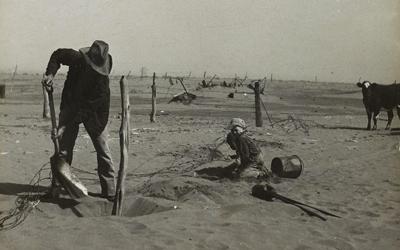
Description
This photograph shows a Dust Bowl farmer raising his fence to keep it from being buried under drifting sand in Cimarron County, Oklahoma.
Farmer Pumping Water to his Dry Fields in Cimarron County, Oklahoma, April 1936
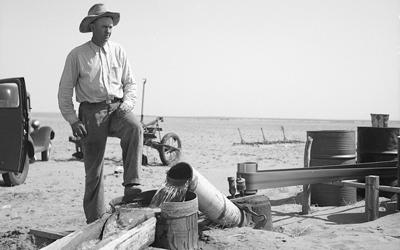
Description
This photograph shows a farmer pumping water from a well to his parched fields in Cimarron County, Oklahoma. One possible solution to the dust problem during this time period in America is irrigation.
Dust Storm in Elkhart, Kansas, May 1937

Description
Packing winds of 60 miles per hour, the loose topsoil was scooped up and mounded into clouds of dust hundreds of feet high. People hurried home, because being caught outside could mean suffocation and death. The dust and darkness stopped all forms of transportation and the…
"FDR Hears Todd Records" Newspaper Article, between 1940 and 1941
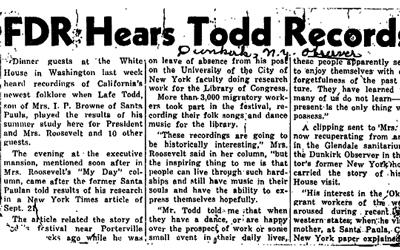
Description
A federal study found that the migrants were spending all they earned on gasoline and housing, with nothing left to feed themselves or their children. The Roosevelt administration answered this by setting up camps to house migrants. The large number of workers…
Interview with Imogene Chapin from Arvin Farm Security Administration (FSA) Camp in California, August 1, 1940

Description
This interview of migrant worker Imogene Chapin, conducted by Charles L. Todd and Robert Sonkin, addressed what life was like in the Arvin Farm Security Administration (FSA) Camp. During the Great Depression, a series of droughts combined with non-sustainable…
Interview with Flora Robertson about Dust Storms in Oklahoma, August 5, 1940
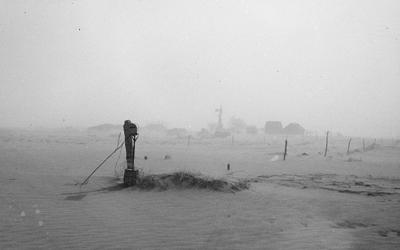
Description
This interview with Flora Robertson was conducted by ethnographers Charles L. Todd and Robert Sonkin. Robertson talks about the drought, grasshoppers and dust storms she experienced in Oklahoma. She also recites her poem about migrating from Oklahoma to California.…
Interview with Mexican Migrant Jose Flores about Farm Security Administration (FSA) Camps, 1941
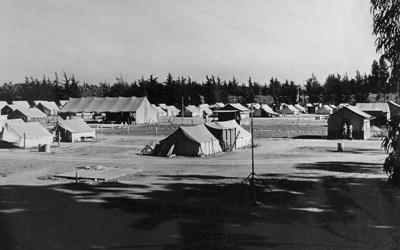
Description
This interview with Jose Flores, who works as a migrant laborer in El Rio, California, was conducted by Charles L. Todd and Robert Sonkin. The interview addresses issues such as Farm Security Administration (FSA) camp governance, camp work, non-FSA migrant camps,…
Ethnographer Charles Todd with Mexican Men and Boys at an FSA Camp in El Rio, California, 1941

Description
In 1941, ethnographers Charles L. Todd and Robert Sonkin documented the lives of migrant workers in California; recording songs, stories, poetry and camp meetings in interviews. Todd and Sonkin did their work with a Presto disc recording machine, recording discs, needles and…
Letter from Martha Fast to First Lady Lou Henry Hoover, January 2, 1931

Description
This 1931 letter is from a girl, Martha Fast, to First Lady Lou Henry Hoover. In the letter, Martha, who is writing from California, asks for clothing from the First Lady as says she has to wear the same dress every day because of the poverty her family is facing during the…
Response from First Lady Lou Henry Hoover's Secretary to Martha Fast, January 7, 1931

Description
This document is the response letter from First Lady Lou Henry Hoover’s secretary to Martha Fast. Fast, a young girl in California, wrote a letter to Hoover a few days earlier asking for clothes.
Dispossessed Arkansas Farmer in Bakersfield, California, 1935

Description
This photograph shows a dispossessed Arkansas farmer who is working on a small shack for his family to live in. These people resettled themselves at the dump outside of Bakersfield, California.
Workmen at the Norris Dam in Tennessee, between 1935 and 1940

Description
This photograph shows workmen in the Norris Dam powerhouse as they are installing a generator. The Tennessee Valley Authority Act of 1933 was created during the Great Depression to hire people to build dams and power plants.
Squatters along the Highway near Bakersfield, California, November 1935

Description
This Dorothea Lange photograph shows squatters along a highway near Bakersfield, California. They are penniless refugees from Dust Bowl. The photograph's description reads that 22 are in this family and they are without water and looking for work in cotton.
President Franklin Delano Roosevelt and First Lady Eleanor Roosevelt in Denver, Colorado, ca. 1936

Description
In July of 1932, in the midst of the greatest economic crisis in U.S. history, Franklin D. Roosevelt accepted the Democratic Party’s presidential nomination, promising "a new deal for the American people." That promise became a series of relief, recovery and reform programs…
"Migrant Mother" Florence Thompson with Her Children in Nipomo, California, February/March 1936
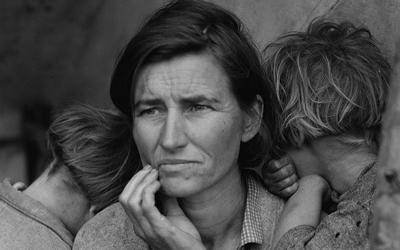
Description
This photograph by Dorothea Lange is part of a well-known collection taken of Florence Thompson with several of her children during the Dust Bowl. The photo collection, known as the "Migrant Mother" series, shows Thompson with her children in a tent shelter in…
Oklahoma Farm Family on Highway between Blythe and Indio, California, August 1936
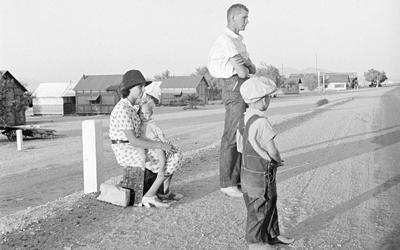
Description
This photograph is an example of self-resettlement in California. This Oklahoma farm family is waiting along a highway between Blythe and Indio. Forced by the drought of 1936 to abandon their farm, they set out with their children to drive to California. They picked cotton…
Rehabilitation Client Repays his Loan in Smithfield, North Carolina, October 1936

Description
The Farm Security Administration (FSA) was created in 1935 as an effort to overcome poverty in rural areas. Under the Department of Agriculture, the FSA helped with rural rehabilitation, farm loans and subsistence homestead programs. This photograph shows a man who is…
Automobile Camp North of Calipatria, California, March 1937
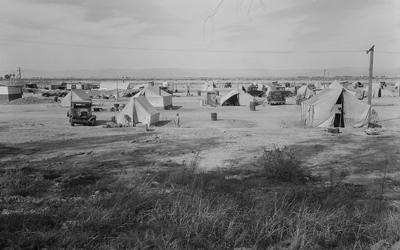
Description
This photograph shows an automobile makeshift camp north of Calipatria, California. Approximately 80 families from the Dust Bowl were camped here. They paid 50 cents a week, and the only available work to them was agricultural labor.
Swimming Pool Created by Civilian Conservation Corps (CCC) Dam in Huntingdon, Pennsylvania, July 1941

Description
The Reforestation Relief Act, gave jobs to 250,000 young men in the Civilian Conservation Corps (CCC). This swimming pool in the photograph was created by a CCC dam in Huntingdon, Pennsylvania.
Additional Resources
- The Charles L. Todd and Robert Sonkin Collecting Expedition
This Library of Congress collection was created by Charles L. Todd and Robert Sonkin, both ethnographers, who provide a glimpse into the everyday life and cultural expression of people living through a particularly difficult period of American history, the Great Depression and Dust Bowl era. This collection features photos, audio and documents of their work. - Library of Congress Teacher's Guide - "The Dust Bowl"
This guide offers historical context, teaching suggestions, links to online resources and more about the Dust Bowl era in America. - Dorothea Lange's "Migrant Mother" Photographs in the Farm Security Administration Collection
Dorothea Lange's "Migrant Mother" photographs of Florence Thompson and her children have become an icon of the Great Depression. This resource provides additional background information about Lange's collection. - The New Deal Primary Sources
This webpage provides an overview of special collections held by the Library of Congress and links to other resources. - History Channel "Great Depression" Collection
There are over 10 videos available at history.com that focuses on different aspects of the Great Depression. Videos and additional resources include a look at such topics as the Stock Market Crash of 1929, The Roaring '20s, President Franklin Delano Roosevelt’s New Deal, among many others. - The Depths of Depression
This resource from the Library of Congress takes a look at July 8, 1932 — the day the Dow Jones Industrial Average fell to its lowest point during the Great Depression. It also provides information about the Dust Bowl and life in America after the stock market crashed. - Rudy Rides the Rails: A Depression Era Story by Dandi Mackall
This children's book takes place in 1932 Akron, Ohio, where a 13-year-old Rudy wants to help his parents during the Great Depression but doesn't know where to turn. Rudy learns of other boys are heading west to seek their fortunes, and he hops a train to live the hobo life while he "rides the rails" to California. - Leah’s Pony by Elizabeth Friedrich: This picture book is set during the Dust Bowl and shows how Leah and her family overcome their impoverished situation through a penny auction.
- Children of the Dust Bowl: The True Story of the School at Weedpatch Camp by Jerry Stanley
This book, which is full of photographs from the Dust Bowl era, tells the true story that took place at the emergency farm-labor camp immortalized in John Steinbeck's The Grapes of Wrath. - The Lucky Star by Judy Young
This children's book from the "Tales of Young Americans" series is set in 1933, as millions of Americans are out of work. The story is about a young girl named Ruth who is dealing with struggles that her family encounters during the Great Depression.
Iowa Core Social Studies Standards (4th Grade)
Listed below are the Iowa Core Social Studies content anchor standards that are best reflected in this source set. The content standards applied to this set are high school-age level and encompass the key disciplines that make up social studies for fourth-grade students.
| No. | Standard Description |
| SS.4.7. | Explain causes of conflict or collaboration among different social groups. |
| SS.4.9. | Explain how enforcement of a specific ruling or law changed society. |
| SS.4.11. | Describe how scarcity requires a person to make a choice and identify costs associated with that choice. |
| SS.4.13. | Compare and contrast different ways that the government interacts with the economy. |
| SS.4.15. | Identify factors that can influence people’s different spending and saving choices. (21st Century Skills) |
| SS.4.17. | Create a geographic representation to illustrate how the natural resources in an area affect the decisions people make. |
| SS.4.18 | Describe how environmental and cultural characteristics influence population distribution in specific places or regions. |